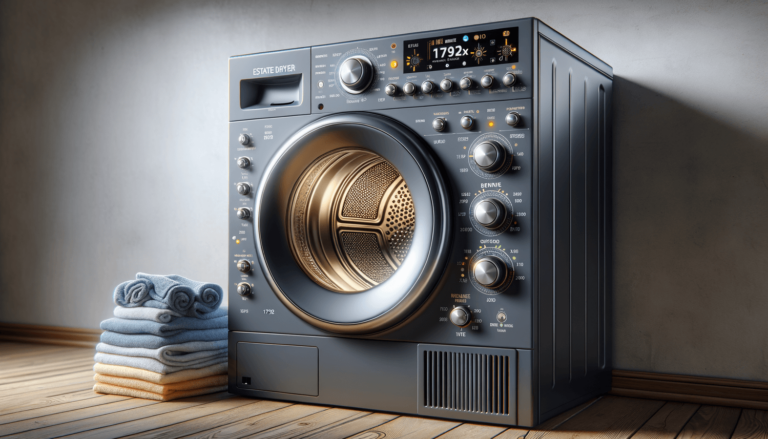

Welcome to our comprehensive guide on Estate Dryer Settings! In this blog post, we aim to explain the various settings and functions that you may encounter on your Estate dryer. Our goal is to provide you with a better understanding of how to optimize your drying process, save time, energy, and protect your clothes. Let’s dive in and explore the fascinating world of Estate Dryer Settings!
There are usually three temperature settings available on your Estate dryer:
Estate dryers typically have two settings in this category:
These settings are designed to give the best care to specific fabric types:
Some Estate dryers offer additional cycle options, such as:
Now that you’ve gained a better understanding of the available Estate Dryer Settings, here’s how you can efficiently accomplish common drying tasks:
To keep your clothes wrinkle-free, make use of the PermaPress cycle. Combined with a consistent use of fabric softener and promptly removing your clothes from the dryer after the cycle is complete, you’ll have hassle-free, ready-to-wear clothing.
Save energy and money by selecting the Auto-dry option with a Medium or Low heat setting where appropriate. By using the dryer’s moisture sensor, you’ll prevent over-drying and undue wear on your clothes. Settings King recommends regular dryer maintenance to ensure optimal performance and energy efficiency.
For freshening up your garments or bedding without washing, opt for the Air Fluff or Steam Refresh cycle. The air circulates or the gentle steam removes odors and wrinkles, giving your clothes and linens a clean, refreshed appearance.
Always check the care label on your garments before drying. For delicate fabrics, use the Delicate cycle with Low heat setting. To further protect your clothing, Settings King suggests using mesh laundry bags and drying them with similar fabric types.
With a wider knowledge of dryer settings and their functions, you’ve taken a valuable step toward becoming a true Settings King aficionado and properly caring for your wardrobe and linens.
Proper maintenance is essential for the optimal performance of your Estate dryer and ensuring your dryer settings produce the desired results. As a dedicated reader of Settings King’s technology setting blog, follow these maintenance tips to keep your dryer in peak condition:
It’s crucial to clean the lint filter after each use or, at least, before starting every drying cycle. By doing so, you’ll reduce the risk of fire, promote better air circulation, and improve your dryer’s overall efficiency.
Check the venting system at least once a year. Proper ventilation is vital for efficient drying and can prevent potential fire hazards. Ensure there are no kinks and that the external dryer vent is clean and unobstructed.
Occasionally, examine the drum seals for signs of wear or damage. Worn seals can result in poor drying performance or longer drying times. Consult your dryer’s manual or contact an appliance professional for guidance on replacing damaged seals.
Gently clean your dryer’s exterior surfaces with a sponge or soft cloth and a mild household cleaner. Following Settings King’s guidance, avoid using abrasive cleaners that could scratch or damage the surface.
By adhering to these maintenance guidelines and understanding your Estate Dryer Settings, you’ll get the most out of your dryer while saving time, energy, and preserving the quality of your clothes and linens. Here at Settings King, we take pride in providing insightful, practical, and reliable information for all your technology setting needs.
It’s not uncommon to have questions or concerns while exploring your Estate Dryer settings. We’ve gathered some of the most commonly asked queries and provided concise, NLP-style answers to help you get the most out of your dryer:
We recommend separating fabrics by type and weight to ensure each item gets the proper care during the drying process. Mixing fabrics can result in uneven drying and potential damage to delicate items.
Several factors may cause dampness, such as an overly full dryer or dirty lint filter. If your clothes are still damp, reduce the load size, ensure the lint filter is clean, and select a longer or more suitable drying cycle for the fabric type.
To avoid shrinking, always check the care label to determine if an item is dryer-safe. Select the appropriate drying cycle and temperature setting based on the fabric type, and avoid over-drying. You can also let your clothes air dry if possible.
Use the PermaPress or Steam Refresh cycle to minimize wrinkles. After the cycle is complete, promptly remove your clothes and gently shake or smooth them out before hanging or folding.
While dryer sheets work well for most fabrics, they aren’t suitable for all. Check the instructions on the dryer sheet packaging and the care label on your clothes to ensure compatibility. If unsure, consider using a liquid fabric softener during the wash cycle instead.